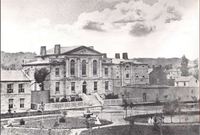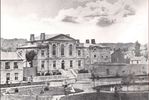
Source: Link
McCARTHY (McCarty), JAMES OWEN (often known as James Owen or Owens), tailor and convicted murderer; b. c. 1794 in Ireland; m. Ann (Hannah) – , and they had several children; d. 31 March 1835 in Hamilton, Upper Canada.
The emigration boom of the early 1830s added a new dimension to the social structure of the villages of Hamilton and Dundas – a large population of Irish Roman Catholics. Mired in poverty in what the local priest, John Cassidy, described as a “rude and toilsome mission,” the Irish seemed particularly prone to the petty violence that characterized frontier towns. Indeed, from the 1830s to the 1850s, the face of such crime in the Gore District was Irish. For Cassidy, the “poverty and the vices” of his flock were a burden. In 1834 he was anxious about the forthcoming St Patrick’s Day celebrations and spent “all the Lent” preaching “against their past drinking their riots and their ignorance.” His efforts were to no avail. On 17 March 1834 a brawl erupted at a Dundas tavern in which “none were concerned but Irish Catholics.” One man died of wounds suffered in the mayhem. Charged with wilful murder were John Rooney, a local innkeeper, and James Owen McCarthy.
McCarthy was a tailor who about 1821 was employed by R. Law and Company of London. Subsequently, he joined another establishment (reputedly tailors to George IV) as foreman. He then opened his own shop in Dublin, which he described as a “large and respectable” business with a select clientele. McCarthy left Ireland about 1832 and opened a store in New York City. Having “lost the whole of his effects by Fire,” he moved with his family to Dundas in the fall of 1833. In jail awaiting trial, he wasted little time before seeking intercession on his behalf. On 26 March he wrote to Frederick Shaw, a former customer and one of the foremost Irish legislators, acquainting him with his situation, asserting his innocence, and begging Shaw to “use your influence with Mr Stanley [the Colonial Secretary] . . . that he might Intercede Immediately.” Shaw forwarded the letter to Stanley, commending McCarthy as a “respectable well-Conducted Man.” Stanley could hardly intervene in the manner suggested but he did forward the documents to Lieutenant Governor Sir John Colborne*, indicating his interest in the case.
Imperial interest was sufficient to ensure the keen attention of local authorities when McCarthy appeared before judge James Buchanan Macaulay* on 4 August, two days after Rooney had been found guilty in spite of the work of his defence counsel, Robert Baldwin Sullivan* and William Henry Draper*. Once testimony was concluded McCarthy addressed the jury with, as Macaulay noted, “great vehemence and gesticulation . . . and instead of manifesting any feelings of remorse or regret, rather exulted in his conduct as amply excusable.” He was pronounced guilty, and Macaulay sentenced both men to be hanged. The judge, however, was a prudent man who was careful to act in accord with the “policy” of the legislature and the “Sense” of the bench with respect to capital convictions. Accordingly, he respited the sentences to allow opportunity for appeal and gubnatorial review.
The usually mute Irish Roman Catholics responded almost immediately to the plight of their countrymen, as did the local community at large. Cassidy, who had earlier dismissed McCarthy as a “loose character,” forwarded a petition bearing 154 names, mainly Irish, which argued that both men were deserving of royal mercy since neither had acted with malice aforethought. The crime had been committed in the heat of temporary passions, “on a day when Irishmen are apt to indulge too freely in the intoxicating cup.” John Law, a local worthy and representative of R. Law and Company, also came to McCarthy’s defence. McCarthy’s own petition for clemency cast his plight in the usual manner. A “stranger in the Country” whose wife and children would be left “destitute and friendless” upon his execution, he sought a pardon “that he may Strive to retain the good opinion of his fellow men, And have time to make his peace with his offended Maker.” In spite of provocation, he maintained, nothing could have induced him “designedly to Shed the blood of his fellow man.” His petition was supported by 307 men, including many of the prominent such as Allan Napier MacNab*.
Uppermost in the minds of McCarthy and his petitioners was the question of intent, for without premeditated design the appropriate charge was manslaughter. Macaulay had touched on this issue in his address to the jury and both his remarks and the jury’s verdict were upheld by Chief Justice John Beverley Robinson*. Colborne, however, was not satisfied and he urged Macaulay to reflect further on the case. The judge, feeling “much repugnance to capital punishments in cases not tainted with deliberate aforethought,” none the less held to his original conclusions and considered the question to be now one for the “Executive Govt.” Colborne referred the matter to the Executive Council, chaired by John Strachan*. On its recommendation, which included respites for both executions, the question was referred in late August to the imperial government. In spite of Macaulay’s repeated confirmation of the Justness of the sentence, Colborne correctly ascribed to him “some doubts” as to whether manslaughter might not have been the more proper verdict. Imperial reservations about the inadequacy of the submitted documents notwithstanding, approval was given for conditional pardons. Before word of the pardons had reached the Gore District – it was sent from Toronto on 23 Jan. 1835 – Cassidy forwarded another petition from the Irish asking for commutation of the sentence. Dreading the personal consequences of attending the doomed men at their execution, he revealed a political awareness hitherto not evident in his community. He alluded to the burning of a Roman Catholic convent in the United States by an “American Mob,” an incident that had occasioned a “Strong Sensation” among his parishioners. What had struck them was the acquittal of American incendiaries and the conviction of McCarthy and Rooney. Irish Roman Catholics were learning, Cassidy stated, the “Strict meaning of Malice pretense.”
Before their pardon (including banishment) was due to take effect on 1 April, McCarthy and Rooney began complaining of the conditions of their confinement in what they described as an overcrowded, poorly ventilated, and unheated jail. McCarthy denounced the jailer’s “Tyranical conduct . . . Such I think as Never disgraced the pages of history.” Sheriff William Munson Jarvis tried to blunt the prisoner’s charges by denigrating his character, noting that McCarthy’s supposed wife (he claimed they had never been married) “has had Causes more than once to regret the Difference between his strength and hers” and that McCarthy himself was “very much addicted to Liquor.” Jarvis hinted at the possibility of a plot to free McCarthy, who had himself vowed “to break Gaol or die in the attempt.” He concluded that there had never been in the jail a “worse Character than Owen the Language he makes use of is enough to make any person shudder.”
On 31 March 1835, one day before his release, McCarthy died “after a dispute with the Gaoler in which much violence took place.” The official conclusion, by a coroner’s jury, that he died of “an enlargement of the heart” touched off a further controversy. In late April McCarthy’s wife presented a petition signed by some 1,200 people questioning the cause of her husband’s “sudden and mysterious death” and wondering why “no action has been taken against the gaoler and his assistants.” In an editorial in the Correspondent and Advocate, William John O’Grady* juxtaposed the inquest, “the verdict of only twelve men,” and the petition of 1,200. “To which should credence be given?” The jailer and his deputy were later absolved of criminal conduct by a grand jury. However, the state of the jails was a matter of both provincial and imperial concern, and McCarthy’s death, probably by reason of the unusual imperial interest in his case and his demise, brought many of the problems to the fore. Two investigations concluded that the jails were greatly overcrowded and inadequately regulated. The second investigation, conducted by a committee of judges including Robinson and Macaulay, was the more important of the two; its report, tabled in the legislature on 22 Dec. 1835, urged the establishment of “more precise and satisfactory regulations than are at present provided.” The result was a statute enacted in 1838 which attempted, with limited success, to bring district jails under a comprehensive system of provincial regulations.
AO, RG 20, F-15, 1: f.4, nos.159–60; RG 22, ser.134, 6, Gore District, 2, 4 Aug. 1834. Arch. of the Archdiocese of Toronto, M (Macdonell papers), AB07.08, .010; AC04.01–2, .05; CA07.04 (mfm. at AO). MTL, Robert Baldwin papers, A73, no.66. PAC, RG 5, A1: 78467–70, 78485–86, 78581–86, 78809–12, 79032–61, 81634–35, 81666–68, 81792–802, 83032–34. PRO, CO 42/423: 89–91, 95–122; 42/427: 25–64. U.C., House of Assembly, App. to the journal, 1836, 1, no.44. Correspondent and Advocate (Toronto), 22 March 1834, 29 May 1835. J. C. Weaver, Hamilton: an illustrated history (Toronto, 1982). Michael Doucet and J. C. Weaver, “Town fathers and urban continuity: the roots of community power and physical form in Hamilton, Upper Canada, in the 1830s,” Urban Hist. Rev. (Winnipeg), 13 (1984–85): 75–90.
© 1987–2024 University of Toronto/Université Laval
Image Gallery

Cite This Article
Robert Lochiel Fraser, “McCARTHY, JAMES OWEN,” in Dictionary of Canadian Biography, vol. 6, University of Toronto/Université Laval, 2003–, accessed April 19, 2024, http://www.biographi.ca/en/bio/mccarthy_james_owen_6E.html.
The citation above shows the format for footnotes and endnotes according to the Chicago manual of style (16th edition). Information to be used in other citation formats:
| Permalink: | http://www.biographi.ca/en/bio/mccarthy_james_owen_6E.html |
| Author of Article: | Robert Lochiel Fraser |
| Title of Article: | McCARTHY, JAMES OWEN |
| Publication Name: | Dictionary of Canadian Biography, vol. 6 |
| Publisher: | University of Toronto/Université Laval |
| Year of publication: | 1987 |
| Year of revision: | 1987 |
| Access Date: | April 19, 2024 |











